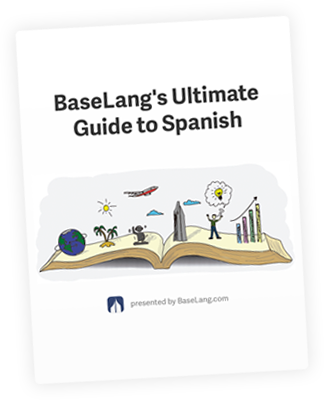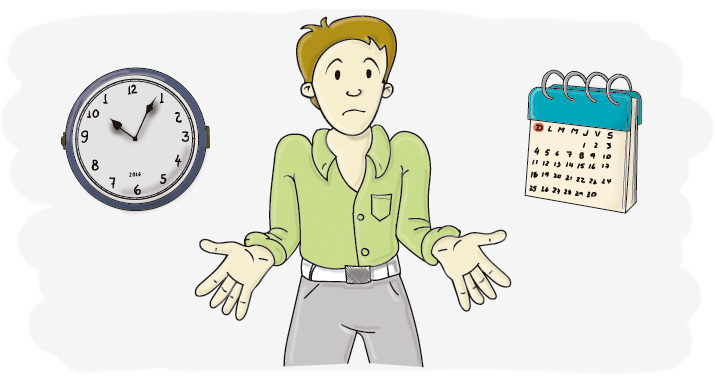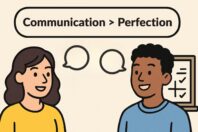Best Way to Learn Spanish: 10 Principles To Follow
Get our free email course, Shortcut to Conversational.
Have conversations faster, understand people when they speak fast, and other tested tips to learn faster.
More infoA couple of years ago, I decided to move to Medellin, Colombia.
I had one problem – I didn’t speak a lick of Spanish. Nada.
I decided to set myself a challenge – learn Spanish in a month, something most people considered impossible.
But, through the ups and downs, I did it. My film, “Spanish in a Month: A Language Learning Documentary”, has since inspired over a million people in every country in the world.
After the documentary took off, I was inundated with people looking for advice or information about how they could repeat the success I had in the documentary.
So I decided to outline the 10 fundamental principles which helped me learn Spanish fast.
Learning Principle #1: Communication Before Perfection
Without a doubt, this is the most fundamental principle.
It’s pretty simple:
Get to communication first, then focus on perfection.
Too many people worry about making mistakes. Maybe you worry that if you make mistakes now, you won’t be able to “un-learn” them later. This makes you petrified of making mistakes, so you never open your mouth and actually speak.
This preoccupation with being perfect is what holds back the vast majority of language learners. If you can let go and stop worrying about being perfect, and just focus on getting your point across – on communicating with another human being – your progress will be so much faster.
You will often surprise yourself when you just spit out a sentence without thinking about it… and it actually ends up 100% correct.
And no, you won’t have any issues “un-learning bad habits”. Trust me, I made a LOT of mistakes early on, and I didn’t spend any time unlearning.
You also won’t be embarrassed if you don’t speak perfectly. In fact, people from Latin America (Spain too) are some of the most friendly and warm in the world (isn’t that part of the appeal?).
I’ll say it again:
Get to communication first, then focus on perfection.
Let that sink in. It’s the most important concept when learning a new language, and the one that will save you so much heartache.
Learning Principle #2: How Long Does It Take To Learn Spanish?
When I tell people I learned Spanish in a month, the typical response goes something like, “really? how? that’s really impressive.”
But I don’t necessarily think a month is impressive.
But if I studied an hour a day for five months, or five hours a day for one month, that’s 150 hours either way.
Suddenly not as impressive.
Which brings us to what is less of a principle, and more of a reality-check: it’s not about how many weeks, months, or years you have spent learning a language, but how many hours.
Because maybe you studied for five minutes a day for a year. That’s only thirty hours – which I spent in six days.
There is only one caveat here, as each speed (as measured in months) has a downside:
- if you learn Spanish in a very short period of time, like I did, you are also more likely to forget it quickly. You need to “maintain” it (which is very easy and basically involves talking to people) once it’s there, or you may forget it.
- if you learn Spanish over a long period of time, like a year, you’ll inevitably forget things along the way and will likely end up needing to re-learn things (which will take less time the second time, of course).
How many months you decide to fit the hours into is up to you and your personal preference.
Personally, it was easier to learn it in a month than over a longer period of time. This is because I’m very good at extreme deep focus for a short period of time, but quite terrible at maintaining little 30-60 minute a day habits.
Maybe you are better at habits, or your schedule simply doesn’t allow more time per day. If that’s the case, you’ll need to do less time a day over a longer period of time.
Either way, measure your hours, not your months.
Bonus: Use our fluency calculator to find out how long it takes to learn Spanish

Download the expanded guide to read later
This page gives you a great overview of the most important concepts and strategies, but for the full, expanded guide, click the button below:
Download Guide Now!Learning Principle #3: Intellectual To Second Nature
In the next principle, you’ll find out why speaking is everything.
But one of the main reasons why speaking is so important is so fundamental to this approach that we need to look at it separately. It has implications on how we approach almost everything – from vocab to grammar to pronunciation.
Let’s pretend you’re learning a single vocab word, “azucar” (sugar).
When you first learn the word, you know it intellectually. It’s in your brain, and you can recognize it. Depending on how well you know it, you can say the Spanish word when presented the English word after a split second to a few seconds.
But when it comes to using the word in real speech in a real conversation with someone, the part of your brain that takes that intellectual knowledge of the word “azucar” and uses it in a sentence hasn’t been used yet.
So, as a preview to how I approach vocab, the process is roughly this:
- Be exposed to a word through your curriculum, teacher, conversation, or other input
- Learn and reinforce the word with flashcards until you can almost always recall it when presented the English
- Use the word a LOT in real conversations to solidify it
The role of speech here is to move the word from “Intellectual” to “Second Nature” (from step two to three).
If you know the word intellectually, you can recall it.
But if you want the word to flow naturally out of your mouth as if it was English, you have to use it in conversations a lot.
This phenomenon is the same with grammar. It’s very similar with pronunciation (where it’s more about muscle memory than your brain). It’s one of the two big reasons you struggle to understand people when they talk fast.
The core of it is so simple and so important that I’ll say it again:
Learn something intellectually and then use speech to make it second nature.
Learning Principle #4: Speaking Is Everything
After “communication before perfection”, this is the most important principle for learning Spanish fast. In fact, it’s the one that makes that one possible.
Speaking. Is. Everything.
Speaking is either the foundation or the most important ingredient in every area of language.
- Want to improve your grammar? Speak more.
- Want to improve your confidence? Speak more.
- Want to improve your listening skills? Speak more.
- Want to improve your pronunciation? Speak more.
- Want to improve your writing? Speak more.
Speaking. Is. Everything.
OK, OK. Let me explain.
First, by speak, I generally mean “have conversations”, not just production (although speaking by itself is helpful for some applications).
Let’s go skill by skill, explaining just how important speaking is to each one.
Speaking
To improve your ability to speak well, you need to practice actually speaking. You’d think this one would be obvious, but so many people end up using apps or textbooks and are surprised when they can’t actually open their mouths and speak Spanish.
The reality is, language is like any other skill: it’s built on repetition. If you don’t speak, you won’t have experience speaking, so while you may understand things just fine, when it comes for your turn to form sentences on the fly, you’ll shut down.
Vocab
You saw how important speaking is for vocab in the last principle, Intellectual to Second Nature.
Essentially, speaking is what takes a word from needing a split second to be said (while you “find it” in your head) to flowing naturally like English.
Confidence
Confidence, evolutionarily, stems from competence. And if you haven’t had a lot of practice speaking Spanish, you won’t have competence, and thus no confidence.
The only way to improve your confidence when speaking Spanish is to speak Spanish. There’s more to it than this, but we’ll cover that later.
Grammar
The same “intellectual to second nature” concept that applies for vocab, applies for grammar.
Whether you learn from a textbook, website, app, or teacher (which I recommend), you’ll only know the grammar concept intellectually until you actually start using it, over and over, in sentences with real people in real conversations. That’s how you “unlock” it, letting it flow naturally like your native language does.
Writing
When it comes to writing, it’s pretty simple: if you can say it, you can write it.
If you can, in the middle of a conversation, dynamically create the sentence and speak it, do you really think you’ll have trouble writing the same thing? No.
But, if you can write something, you can’t necessarily speak it. This is the problem that those in the university system face, for example: they can write essays in Spanish, but lock up when someone actually speaks to them.
This is partly because they don’t have practice on that end of the spectrum, and partly because while writing lets you sit and think and fix things, speaking happens on the fly and doesn’t give you the luxury of time to think.
Thus, if you spend more time speaking, you will improve both your speaking and your writing.
Messaging a little with friends is more than enough writing practice (and you don’t necessarily even need that). Of course, if you want to become a very good writer in Spanish, you need to write a lot – but that’s true even of your native language.
Listening
Many people struggle to understand people when they talk fast.
Depending on the country, the speed of speech can seem to range from fast to lightspeed. How are we non-natives supposed to keep up?
Well – we can – but there are a lot of things we need to do to train our ears to keep up.
But guess what is an important part of training listening skills? You guessed it. Having conversations.
Pronunciation
The first step in good pronunciation is learning how to properly make the sounds. I’ll cover how to do that later on, but let’s assume for now that you can make the sounds correctly.
Once you can physically make the sounds, you need to use repetition as it’s like any other skill in that you have to practice it for it to become second nature.
So, you need to get in the reps saying each sound over and over in real words to train your mouth to make the sounds naturally (I’ll explain this in more depth later).
And, of course, speaking (by itself) is the only way to get in these reps, and conversations (including another person) are a more fun way to do it.
Why Other Strategies Fail
This is one of the reasons why you didn’t learn much in high school or university. Aside from the un-optimal curriculum and focus on perfection, you get almost no speaking practice at all (if any).
It’s why tapes, by themselves, don’t work – you need conversations or you just have input and no output. There’s also obviously nobody there to explain things to you when you get confused, which happens a lot.
It’s why apps like Duolingo or software like Rosetta Stone don’t work. Among other issues, they all ignore speaking.
Learning Principle #5: How To Talk About Anything
“But you don’t understand, I need to learn medical Spanish. I don’t need the normal stuff.”
I was in the middle of a conversation with someone who emailed me for advice after watching the documentary. They wanted to work in urgent aid in Latin America.
What I explained to them next is the “secret” to how to talk about any subject (if you even want to call it a “secret”).
All you need to do to learn how to talk about any topic in Spanish is to learn the vocabulary for that topic.
There’s nothing different about “medical Spanish” from “normal Spanish”. It’s just extra vocabulary.
No matter what you want to talk about, you need the same fundamentals. You need the core vocabulary that everyone uses all of the time.
Then, if you want to talk about a specific topic or field, like medicine, all you do is learn the words for that topic.
Verbs like “to bleed” and “to sew” and “to break”. Nouns like “surgery”, “kidney”, and “vaccine”.
New subjects are just vocab hung on the framework of “core Spanish” you have to learn first.
Opening up entire new worlds in Spanish is a simple as learning some new words.
Learning Principle #6: 80/20 Everything
If you’re already familiar with the 80/20 Rule (also called the Pareto Principle), you can probably skip this. Just know that it applies BIG TIME with Spanish.
The 80/20 Rule basically states that 80% of the results come from 20% of the inputs.
80% of the pea pods are produced by 20% of the plants.
80% of the revenue is created by 20% of the customers.
80% of the headache in support is created by 20% of the customers.
And 80% of spoken Spanish uses 20% of the language.
Well, actually, that last one isn’t true.
You need to know much less than 20% of the language to understand 80% of social conversations.
The most commonly used grammar and vocab (which is a rather small percentage of the total words, conjugations, and complex grammar in Spanish) allows you to understand often over 80% of what you’ll hear in Spanish.
What you learn (being effective) is more important then how you learn (being efficient). So, you can cut months off your learning curve by cutting a lot of material out of your curriculum.
What This Looks Like In Practice
For example, it means that:
- Until the advanced stages, you don’t learn the majority of the different conjugations (of which there are a LOT, but most of which are almost never used). You just learn the most commonly used ones.
- You learn the most commonly used vocab first (based on frequency lists), and the “niche” vocab that you personally will use a lot (things you are interested in and thus talk about).
- You stack the most important/most commonly used stuff first, as it will give you the most bang for your buck.
The curriculum and stages of learning I present here have 80/20’d everything to the Nth degree, so luckily you don’t have to do the work of figuring out what stuff is the most important.

Download the expanded guide to read later
This page gives you a great overview of the most important concepts and strategies, but for the full, expanded guide, click the button below:
Download Guide Now!Learning Principle #7: Does Duolingo Work?
How many people do you know that have successfully learned a language to fluency using apps? Using just a computer?
Introducing the most advanced technology the world has ever seen. Features include:
- impeccably accurate voice-recognition, with no annoying errors
- state-of-the-art pronunciation feedback
- infinitely interesting and engaging, with hundreds of millions of different versions to try
- built-in accountability
- scientifically proven
Introducing… humans.
Language is about communicating.
Language is about having real conversations.
Language is about connecting with a culture.
Language is about people.
But even if those weren’t true, the fastest way to learn a language to actual fluency would still be spending as much time as possible speaking and having conversations with real people.
All the little fill in the blank, click the picture, multiple choice bullshit you’re doing in Duolingo, or whatever app you are using, is training you to be good at THAT. But it’s not going to help you much when you need to actually turn around and open your mouth to have a real conversation with a real person in Spanish.
Introducing George
I have a good friend. We’ll call him George.
George had been using Duolingo for two years, diligently doing a little bit every single day. He’d long finished the entire curriculum. George then moved to Medellín, Colombia for a few months.
When George arrived, on paper, he knew almost as much, if not more Spanish than I did. He certainly knew more grammar, and could probably crush me in a written test.
But guess what? He spent his entire time using software, and almost no time talking to real people. And when he arrived in Colombia, in a real, Spanish-speaking country, he couldn’t actually have conversations.
He could handle the basics, and that’s about it – because he had never practiced actually speaking and understanding a native speaker in the real world.
So, when he arrived, he took my advice, and started speaking a lot. And within two months, he had a local girlfriend and a circle of Colombian friends, most of which spoke little or no English at all. People he never would have connected with if he didn’t actually speak Spanish – if he had only ever used software.
The only caveat to this is that computerized flashcards are good for vocab (and vocab only), when paired with speaking and other things. We’ll cover that later.
Don’t try to learn a new language from software. Speaking is everything.
Learning Principle #8: Do You Need A Teacher?
I get asked a lot, “do I really need a teacher to learn Spanish? What if I just do it on my own?”
Well, no. It’s not absolutely required to learn the language. People have learned it before with no human assistance and will continue to do so. But…
- Why? You are learning Spanish to communicate with Spanish-speakers, which are people. If the whole point is to speak with people, why would you cut that out, even if it didn’t help?
- It’s slower. For reasons I’ll cover in a second, having a teacher speeds things up enormously.
- It’s not as good. You won’t learn slang or how people speak in the street (why this is important is covered in the next principle).
- It’s not as expensive as you think. More on my favorite tools for learning Spanish later on. But if you’re already itching to start some classes, take a look at BaseLang (we wrote this guide!), where you can get unlimited one-on-one Spanish classes with professional teachers for just $179 a month. Your first week is just $1 so you can try it out.
So if you absolutely want to learn Spanish without human assistance, go for it. But, I don’t advise it, as most of the principles that helped me learn Spanish in one month will be of little use to you as the bedrock of my approach is built on conversations with real people.
Teachers vs. a Language Exchange
By this point, you should be convinced that you need to speak, that conversations with native speakers are very important.
One of the most common questions I get is, “why should I pay for a teacher when I can do an exchange for free? Is is really worth it?”
Yes.
First, let’s look at the pros and cons of an exchange.
Pros
- Free
- Large selection of people
- People are from many different Spanish-speaking countries
Cons
- English skills aren’t usually very good when you need an explanation
- You need to tell them what to teach you next, which requires you to know what you even need to learn in the first place (which you don’t – even I didn’t past a certain point during the documentary)
- You have to spend half your time speaking in English (it’s an exchange after all), which is very time-inefficient
- The person probably isn’t that great at explaining things. In fact, you probably can’t explain English well either, because as a native speaker, things just make sense.
- For instance, what’s the difference between “may” and “might”? Or why we say “big, red house”, not “red, big house”? It’s the same for a native Spanish speaker that hasn’t been trained to teach – they don’t know why things are the way they are, and can’t explain things better than, “I don’t know, that’s just how it’s said”.
In contrast, a professional teacher…
Pros
- Since they are professionals, they can actually explain different concepts as they have a deep understanding of both Spanish and English – and thus can explain the differences between them and relate Spanish grammar concepts to how things work in English.
- You spend the entire time learning Spanish.
- The teacher gets invested in your success and can guide you through the process. They know you, your interests, your progress, and your weak points.
- They know what you need to learn next, so you don’t have to tell them what to cover.
- They, quite frankly, make you feel awesome. They make you feel like you are getting it. Mistakes no longer feel embarrassing. They know not only how to teach you the language, but to coach your psyche to make sure you actually feel like you are progressing (because often, you won’t).
- Per above, teachers make gaining confidence to actually speak so much easier because it’s no longer scary.
- The best teachers are good at a level we don’t even notice. In a seemingly casual conversation, they will ask questions that will force you to use the concept you just learned. They will pretend they’ve never seen a particular movie just you’ll have to explain it to them for more practice.
- They can somehow dumb down their own Spanish to almost only use the grammar and vocab that you either already know or are learning. You think (and feel like) it’s just a casual conversation, but behind the scenes, there’s a lot going on.
Cons
- They aren’t free. But, they can be a lot more affordable than you think
- I’ll cover one good option in a minute.
- BUT, depending on what you make an hour, it is likely a smarter financial decision to pay for the tutor. This was my own logic, when I decided to spend $1,350 in a month on my tutor for the documentary (3 hours a day for 30 days straight):
- Assuming that a teacher is no better/faster than an exchange (definitely not true), an exchange doubles the amount of time it would take for you to learn Spanish.
- I estimate roughly 150 hours to a conversational level, using the methods in this course, starting from zero. Since an exchange, in this hypothetical situation, doubles that… how much money could you make in 150 hours, and couldn’t that cover more than the cost of your teacher?
- For most people in the western world, it makes more sense to work a little bit more and pay for a tutor. You’ll still come out ahead on time.
- But if you can’t afford $15/hr, don’t worry. You can get unlimited classes for just $179 a month with BaseLang. The teachers are all professionals that work for us, so you’re getting all of the benefits of having a teacher for a lot less money. Your first week is just $1, so you can see if you like it first. Click here to sign up.
- If you don’t want to use BaseLang, that’s cool too. Whether you use us or not, we still suggest you use a teacher.
So yes, I definitely recommend a teacher.
Is it possible to learn Spanish without one? Absolutely. And an exchange is better than nothing. But since it takes so much more time, you are more likely to give up – and that’s assuming you’re on a very relaxed schedule.
If you want to learn Spanish fast, getting a teacher is vital.
Learning Principle #9: Be Native
This is an issue that only plagues a small percentage of people, but enough that I need to cover it. Maybe you haven’t been infected.
Some people think they don’t need to try to sound as native as possible when speaking Spanish. Typically, they either…
- Think it’s un-cool to actually say things correctly, instead of in a gringo accent. This is a big issue in traditional education when most of the people around you have terrible accents and will make fun of you if you actually sound latino.
- Or, they think that “they understand me, it doesn’t matter”. Yea, sure, maybe they do usually. But isn’t the whole purpose of speaking Spanish to connect with Spanish-speakers? It’s a fact (whether we like it or not), that people like people similar to them. When you speak in a gringo accent, you are instantly less familiar to them, which inevitably means they don’t trust you as much and the connections don’t get as deep, typically. This isn’t their fault – this is just stuff happening subconsciously.
- This of course assumes they do understand you and that your gringo accent has decent pronunciation. Often, you’ll have to repeat things an extra time. You could have said it perfectly, but having to repeat it will be terrible for your confidence as you will have to wonder if you screwed something up.
When you make an effort to sound local – not just in your accent, but also in the words, phrases, and slang you use – you unlock an extra dimension.
People are suddenly a bit warmer with you. They feel more comfortable right away (this is why I intentionally use very local Spanish where I live in Medellin, especially when first meeting someone).
And maybe, you’ll reach the holy grail of Spanish: being mistaken for being part-latino (or latina).
The Arepa Joint in NYC
Earlier this year, I was in NYC for a week, visiting some friends.
One of my buddies, Pieter, recommended that we go to an Arepa joint near where he lived. If you don’t know, an arepa is a flat, usually round, bread made of corn. There are many different types, but this particular restaurant served a type of Venezuelan arepas that are hollow in the middle. They are opened up then stuffed with different variations of meat, cheese, vegetables, sauces, and other (very) delicious things.
My entire week in NYC, I had been trying to talk to people in Spanish. My accent is very good (probably the strongest part of my Spanish, as a whole), and I was saying things correctly, but people would just switch back to English.
But, at this little arepa shop, the guy (from Venezuela) actually spoke back to me in Spanish. I laughed with him and talked for a little bit. It wasn’t a necessarily “hard” conversation in terms of the subject matter, but we were speaking pretty quickly.
At the end, I asked where he was from.
(Translated)
“where are you from?”
“Venezuela.”
“Where in Venezuela? I have some friends there.”
“Maracaibo.”
“Oh, that’s awesome!”
“Where are you from?”
“I live in Medellín – Colombia.”
“Ah, that makes sense, I was trying to place your accent. You’re from there?”
“No no, I’m from Florida, I just live there now.”
“But you’re part latin? One of your parents or something?”
“(laughing) No.”
When I told Adrian this story, his immediate reaction was “whoooooaaaa”, which he followed with a high-five.
Trust me – I don’t look latin at all. That’s a big compliment.
And it’s not that unachievable.
But you need to try to sound local.
It makes a difference.
Bonus Reason to Become Native
Here’s another reason to try to be as native as possible: it’s awesome.
Seriously, learning the slang and little sayings and phrases of a specific city or region is probably the most fun thing you can do when it comes to Spanish. Since I live and learned everything in Medellín, where people are “paisas” (the word for people from the region), my slang, accent, and speech patterns are all very paisa. We laugh that I speak don’t speak español, but “paisañol”.
You may think that you should just carry a neutral accent and not sound from any one place. And if you are doing business in many different Spanish speaking countries, perhaps that’s true. But if not, picking a place to “be from” gives your Spanish some flavor and gives you a sense of identity.
This is of course somewhat dependent on you traveling or living in a Spanish-speaking country. But if you are in the US, look at the latinos in the nearby neighborhoods or your Spanish-speaking friends, and see where they are from. Learn the slang relevant to them (they will have a blast teaching it to you, trust me).
You’ll learn some hilarious stuff. Here are two examples from Colombian Spanish to whet your appetite:
1. Quién pidió pollo?
“Who ordered chicken?” While this could literally mean “who ordered chicken”, it has another, very funny meaning.
This phrase is used in groups of Colombian women when a very attractive man walks into the room. The man is the “chicken”.
This makes absolutely no sense at all. The best explanation a friend of mine got was that chicken used to be rather rare in Colombia for some reason (I don’t know if this is even true), so it is used in this phrase to point out an attractive guy.
2. Arroz en bajo
Another one from the dating department, this mean “rice on low (on the backburner)”.
It’s used primarily by women (though also by men) to describe men they aren’t even remotely serious about seeing, but are talking to a little bit, “just to keep them interested”. Arroz en bajo means keeping the man (or woman when this happens the other way around) “warm”, so that if she has a Friday with no plans for some reason, that she has someone to do something with.
There’s a LOT more, and it’s a ton of fun to learn, and even more fun to use, especially when people aren’t expecting you to know it.
Other than asking, and the rare good resource on regional slang, the main way to learn this (or pick up something odd so you can ask what it means) is through mimicry, which is covered later on.
Be native. It’s worth it.
Learning Principle #10: Mindset Matters
A few months ago, a friend of mine and I had coffee in Medellín and we started talking about personal development – specifically one month challenges.
At one point, he asked me how I overcame the incessant inner doubt that “I can’t actually do this”, or “who am I to try to do this?”
My answer surprised him, and his question made me think about the mindset side of things that I took for granted.
I responded, “I don’t have those doubts. I go into one of these challenges and literally have zero doubt at all that I can pull it off. I’m not a fool – I have done my research and put everything in place to help me do it. But once I’ve started, I have no doubt to fight off.”
Now, this friend is no average guy. He’s had a lot of success with several businesses, relationships, languages, and personal development.
So it made me realize just how uncommon my irrational (potentially arrogant) confidence is when going into a new challenge to which I’ve fully committed.
And after some thought, I realized just how key your mindset really is, especially when it comes to learning Spanish.
Going in, the most productive mindset is…
- I’m good at Spanish
- Spanish is easy and this is fun
- I can’t fail, why would I ever give up? Look at how awesome I am at this
These don’t need to be rational or true. They may not be. But either way, they help you – so why not try to adopt them?
But, a lot of people have destructive mindsets going into the process of learning Spanish…
- Spanish is hard
- I’m bad at languages
- I’m too old and my memory is bad
- He/she might be able to, but I can’t
- I have to be perfect
- I failed at all my other goals, why am I kidding myself that I can do this one?
These mindsets are toxic. Even if they aren’t true (and they aren’t), they will hinder your progress substantially.
Conclusion
And there it is, you now know the 10 principles that guided me when making my documentary “Spanish in a Month”
I wrote more about how you can apply these 10 principles in a separate 119-page book that also details my strategies for learning vocabulary & grammar, nailing pronunciation, and much more to help people like you learn Spanish fast.
You download the entire book, for free, below.

Download the expanded guide to read later
This page gives you a great overview of the most important concepts and strategies, but for the full, expanded guide, click the button below:
Download Guide Now!




